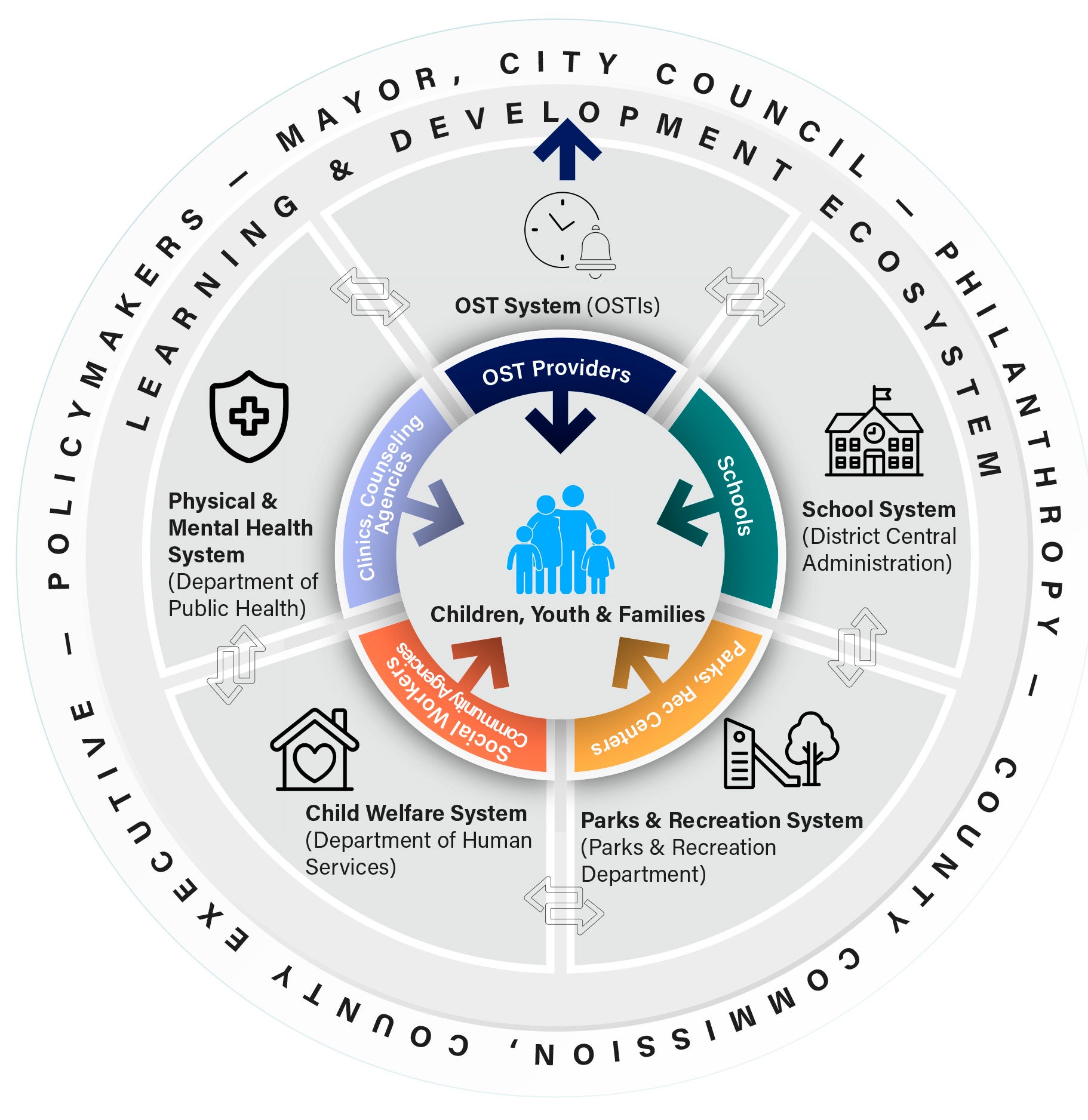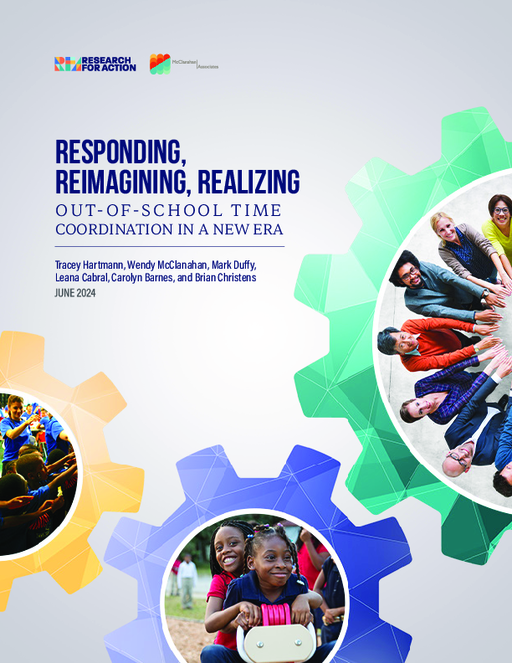Breadcrumb
- Wallace
- Reports
- Responding, Reimagining, Realizi...
Responding, Reimagining, Realizing
Out-of-School Time Coordination in a New Era

- Author(s)
- Tracey Hartmann, Wendy McClanahan, Mark Duffy, Leana Cabral, Carolyn Barnes, and Brian Christens
- Publisher(s)
- Research for Action and McClanahan Associates
Summary
How we did this
The researchers conducted interviews or focus groups in 12 cities. Some 136 people took part either as interviewees or focus group participants. They included staffers in out-of-school time coordinating organizations, city government, school districts, and funder organizations. The research team also surveyed program providers in six of the cities and received responses from 163 people. In addition, the researchers interviewed 49 caregivers. The report contains early findings from those interviews.
The year 2020 marked the onset of the global COVID-19 pandemic. With that began many months of school shut-downs and on-again, off-again hybrid learning. The year also marked the beginning of a racial reckoning that continues in the U.S.
This report looks at how the organizations that coordinate and support a community's afterschool and similar programs—often called “Out-of-School Time Intermediaries” or “OSTI’s”—responded to these developments. It finds they made substantial contributions in helping communities during the pandemic and addressing the inequities made worse by the health crisis. It also says their experiences suggest possibilities for the important role they can play in supporting communities moving forward and in fostering better and more equitable services for young people in the future. The report is based on one of the largest and most comprehensive studies to date on OST coordination activities during the pandemic.
What intermediaries did during the pandemic years
The study calls these organizations “out-of-school time intermediaries.” “OST” refers to afterschool, summer, and other programming beyond the school day. The intermediaries have a range of functions, from setting quality standards for programs to providing staff development.
The report breaks down their pandemic response into three categories:
- Working and advocating for program accessibility and responsiveness to young people’s needs. This entailed several different sets of actions. The intermediaries delivered professional development on a range of matters to OST programs. One was how to offer services to children virtually once pandemic shutdowns began. Another was how to bolster the mental and emotional well-being of both young people and program staff members. In addition, intermediaries held virtual meetings with program providers that were less structured than the in-person kind. These meetings were highly valued by the providers because they allowed programs to learn from and give each other emotional support at a highly stressful time.
The intermediaries also advocated with city, school district, and private funders on an array of financing issues. Among them: ensuring that federal COVID relief funding would help OST providers.
- Strengthening or forming partnerships with other institutions to support families. Intermediaries partnered with all kinds of civic agencies, from libraries to parks and recreation departments to mayoral offices. Chief among these were partnerships with school districts. They helped lead to something essential: centers where children could learn online during the pandemic while their parents worked. The intermediaries helped set up and operate these learning centers in many ways. A partial list:
- They found spaces to house the centers and recruited trusted OST providers to run them.
- They helped arrange for funding, technology, and basics such as meals and the protective equipment needed during the COVID crisis
The intermediaries also conducted wellness checks with families during quarantines. Once schools reopened, they identified students who had not returned to the classroom and coordinated efforts to reach out to their families.
- Working to advance equity in the community’s system of OST programs. The intermediaries made many moves on this front. They examined equity in their own organizations through such means as auditing internal practices. They sought staffing and leadership that better reflected the communities they served. Other actions included:
- Adjusting funding distribution to the needs of the youth being served
- Offering program stipends to older youth who otherwise would have had to work and forego attending programs
- Broadening their reach to more grassroots program providers led by people of color and lowering their barriers to funding. Specifics included things like serving as a fiscal sponsor for such programs to help with insurance and other needs, and assisting in grant applications
What possibilities does this work suggest for the future?
The OST intermediaries showed that they have the wherewithal to help communities and OST systems meet new developments and circumstances as they arise. This suggests continued efforts in four areas:
- Responding to the emerging needs of young people post-pandemic in areas such mental and emotional health
- Advocating to support and sustain practices that bolster equity in OST programs
- Making the most of partnerships to respond to the needs of families
- Advancing equity in OST systems

They’re able to advocate differently than us as individual organizations…. It’s getting in front of the “right people” who have the ability to enact changes or to move resources differently.
Related Reports
- Making the Connections: A Report on the First National Survey of Out-of-School Time Intermediary Organizations
- Growing Together, Learning Together: What Cities Have Discovered about Building Afterschool Systems
- Building Citywide Systems for Quality: A Guide and Case Studies for Afterschool Leaders
- Hours of Opportunity: Lessons from Five Cities on Building Systems to Improve After-School, Summer, and Other Out-of-School-Time Programs (Volumes I, II, and III)
- Investments in Building Citywide Out-of-School-Time Systems: A Six-City Study
- Putting Data to Work for Young People: A Ten-Step Guide for Expanded Learning Intermediaries
- Stability and Change in Afterschool Systems, 2013-2020: A Follow-Up Study of Afterschool Coordination in Large Cities
Key Takeaways
- OST intermediaries played an expanded and substantial role in pandemic response and recovery.
- They acted as valued partners to school districts and city agencies in providing support to families.
- Their efforts suggest they can make a valuable contribution in the future to citywide efforts to assist families and children and press for greater equity in OST programming.
Visualizations
The Role of OSTIs in the Learning and Development Ecosystem

What We Don't Know
- This study represents 12 urban centers of a certain size and is not representative of the full range of coordination experiences in all U.S. cities. How did OST intermediaries in other communities approach their response?

